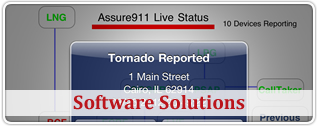Almost all providers of software in the NG9-1-1 industry, while committed to interoperability and adherence to standards, are in the end only responsible for and therefore dedicated to the quality of their own products and services. The 9-1-1 ecosystem is broader than the NG9-1-1 core and PSAP premises components. The firms who are 9-1-1 SSPs for NG 911 deployments, have realized the need to monitor all components of the multi-vendor platforms that they place onto the ESInet, and encouragingly in some cases, the ESInet itself is included in that monitoring. However, the ecosystem, both in the case of legacy E9-1-1 and Next Generation 9-1-1, is broader. It includes equipment, software and the underlying network transport, power and other services that support all phases of 9-1-1 call management, from call origination, to database service providers, and on to the PSAPs for dispatch to the First Responders.
The evolving NG 9-1-1 industry has challenges and opportunities with Reliability and Quality of Service. Parties who share in the end to end network service quality can benefit from real time information sharing between parties on a limited basis. The FCC sees this as a critical area to which attention must be given. At recent IEEE CQR Workshop in Charleston, S.C., Admiral David Simpson mentioned this in his keynote speech as prominently as the need to improve indoor location accuracy. Vendors and Systems Integrators in this space were asked to accept this challenge. At Assure911, that is the focus of our work.
There are specific trends that are interrelated here – on one hand, primary 9-1-1 SSPs are looking to reduce costs. Traditional large carriers 9-1-1 SSPs are transitioning to the role of subcontractor, providing underlying network infrastructure and in some cases looking to reduce their 9-1-1 SSP roles. New 9-1-1 service providers intent on supplying outsourced services as well as those providers intent on taking over the role of primary must succeed in maintaining not only the reality of reliability, but the perception as well. The progress of the national roll out of Next Generation 9-1-1 depends on their success.
An impressive definition of the perception of reliability was expressed by a town manager who said that people in his jurisdiction, upon encountering someone bleeding, would take the time to dial 9-1-1 first, and only attend to the injured person after that. The expectation of success in obtaining necessary assistance in a rapid manner is so high that people don’t hesitate to leave someone to bleed a few more moments while investing the time to make the call. That is a perception that might be hard to match, but it should be the goal. It is the bar set by the success of the existing legacy infrastructure and the ability of the 9-1-1 SSP in that area to operate it reliably.
We look forward to helping the 9-1-1 industry achieve such a high level of reliability in both perception and reality.






